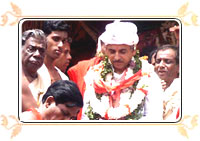

Chhera Pahanra - Emperor as Sweeper of the Chariots
Dr. Subas Pani
 The second phase of the festival is an equally colourful and elaborate ritual is known as Chhera Pahanra. The Raja, King of Puri, Gajapati Divya Singha Deva is informed of the deities having taken their places on the chariots through a messenger specially deputed by the temple officials. The young, handsome King, clad in spotless white, carried in a silver plated palanquin leaves his palace and comes in a small procession on the grand avenue led by a caparisoned elephant. He climbs the chariots one by one. He first offers his prayers to the deity seated on the chariot. He then cleans the platforms with a golden broom, sprinkling flowers and fragrant water on the surface of the chariot.
The second phase of the festival is an equally colourful and elaborate ritual is known as Chhera Pahanra. The Raja, King of Puri, Gajapati Divya Singha Deva is informed of the deities having taken their places on the chariots through a messenger specially deputed by the temple officials. The young, handsome King, clad in spotless white, carried in a silver plated palanquin leaves his palace and comes in a small procession on the grand avenue led by a caparisoned elephant. He climbs the chariots one by one. He first offers his prayers to the deity seated on the chariot. He then cleans the platforms with a golden broom, sprinkling flowers and fragrant water on the surface of the chariot.
The ritual goes back several hundred years and is a symbol of the subjugation of the temporal to the spiritual. The emperors of Orissa, beginning with the valiant Anantvarman Chodagangadeva in the 12th century, had declared themselves to be the rauta, servant of Lord Jagannatha and ruled the land as His representative. The ritual is also a public demonstration of the unique philosophy of integration and unity symbolised by Lord Jagannatha. There is no distinction of caste, creed or any other barrier during the entire festivities. After cleansing of the chariots by the Raja and his departure to the palace, the wooden horses, brown, black and white, are fixed to the three chariots. Thick ropes made of coconut fibre and 250 feet long are tied to the individual chariots.
Designed, developed and hosted by
इस वेबसाईट का निर्माण, विकास, होस्टिंग एवं रख-रखाव द्वारा
Ministry of Electronics and Information Technology
इलेक्ट्रॉनिक्स और सूचना प्रौद्योगिकी मंत्रालय
![]()